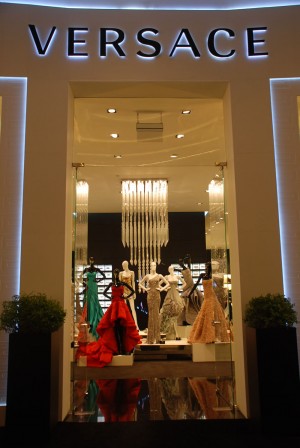Earlier, we described research that demonstrated that when men are reminded of mating, they tend to engage in conspicuous consumption (i.e., buying that new Mercedes) as a way of signaling their potency as mates. And, we discussed research that demonstrates that, indeed, when women are at their most fertile, they are drawn to such displays.

Research suggests that women are particularly tempted to appearance-related spending during their most fertile periods.
But women are not simply the audience for costly signaling. Women do a good deal of signaling themselves, and the menstrual cycle appears to exert a strong influence on women’s spending in general. Gad Saad and colleagues in Montreal found that when women are in the most fertile phase of their menstrual cycle, they are more likely to buy appearance-enhancing items, such as clothing and jewelry, than when they are in the earlier or later phase of menstruation. Importantly, women are not likelier to spend in other categories while ovulating — the effect is limited to items that would enhance their attractiveness as sexual partners. This makes sense from an evolutionary perspective: when women are most likely to conceive, they are most interested in attracting attention from potential mates.
Earlier research had tied women’s spending to their menstrual cycle, as well. Researchers in the UK found that when women were in the post-fertile phase of menstruation, they were more impulsive in their spending than during other times of the month. Women in their post-fertile phases of menstruation also tended to over-spend and to spend in ways they later regretted. While the researchers did not offer potential explanations for why women’s spending would be affected in this way, they strongly suggest that hormonal changes that occur throughout the menstrual cycle are likely responsible for the changes in spending, just as they are for the well-documented mood swings associated with the post-fertile phase of menstruation.
The implications from the research are clear: Whether or not we are consciously aware of where our impulses to spend come from, we tend to spend money in ways that are tied to deep evolutionary factors, most notably finding a mate. It is not necessary that we be consciously thinking of mating for our actions to be strongly influenced by factors that were originally tied to the competition for mating opportunities.

Between impulsive spending during the post-fertile phase, and appearance-related spending during the fertile phase, women may find themselves up to their eyeballs in consumer debt.
Armed with this information, perhaps it will be easier to resist such hormonally driven temptations to spend.
At BeyondThePurchase.Org we are researching the connection between people’s spending habits - how do you spend your money and who do you spend it on - and whether that results in more or less happiness. We are also interested in understanding how our personalities, our life histories and the environments we live in influence how we think about and spend money. To learn about what might be influencing how you think about and spend money, Login or Register with Beyond The Purchase, then take our a few of our spending habits (Experiential Buying Scale, Materialistic Values Scale, and Compulsive Buying Scale), and values and personality (Please Register to Take Study Dispositional Positive Emotion Scale, and our Beliefs about Well-being.
This blog post was written by Kerry Cunningham. Follow @kerryfc
This post is based on the following research papers:
Pine, K. J., & Ben C Fletcher. (2011). Women’s spending behaviour is menstrual-cycle sensitive. Personality and Individual Differences, 50(1), 74–78.
Saad, G., & Stenstrom, E. (2012). Calories, beauty, and ovulation: The effects of the menstrual cycle on food and appearance-related consumption. Journal of Consumer Psychology, 22(1), 102–113.
Saad, G., & Vongas, J. G. (2009). The effect of conspicuous consumption on men’s testosterone levels. Organizational Behavior and Human Decision Processes, 110(2), 80–92.

